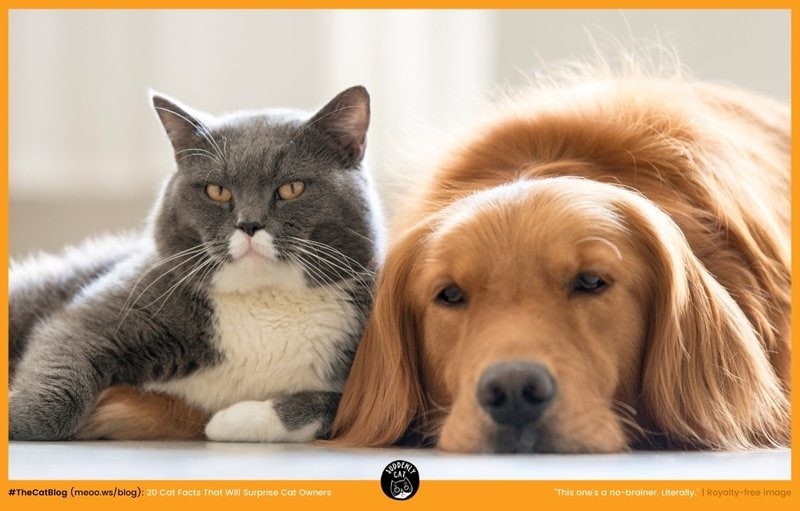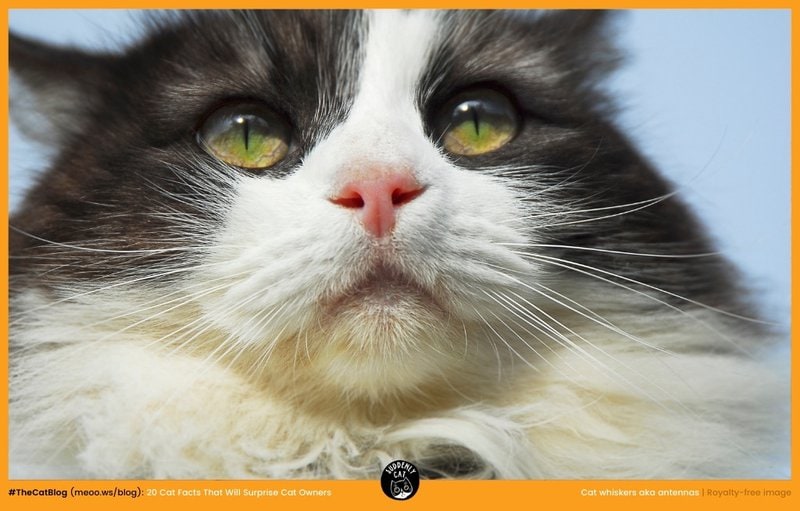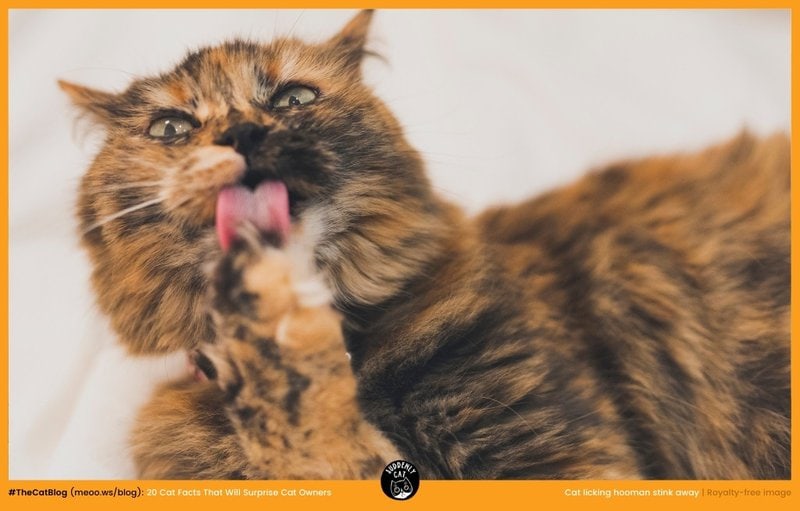
20 Cat Facts That Will Probably Surprise Cat Owners
Cats are without question some of the most beautiful creatures on this planet. Ruling majority of western households, cats are among the most popular pets in the world and there’s plenty of good reasons for that – they’re furry, they’re funny, they have meow-sterious personalities and are overloaded with cuteness.
‘Hoomans’ have been obsessing over them for thousands of years… even leading some to build pyramids in their honor! So you’d think we’ve got all the information about cats figured out by now, right?
Wrong!
There are plenty of interesting feline-facts that even the most dedicated pet owners probably haven’t heard. So we've put together 20 mind-blowing real facts about cats that’s going to help you know our furry friends a little better.

1) Cats spend two-thirds of their lives sleeping
Domestic cats are known to be famous for three things: eat, sleep, play and repeat! But did you know our feline friends tend to spend almost two thirds of their day sleeping? That translates to an average of fifteen hours a day, which means cats dedicate up to 70 percent of their lives solely to snoozing. Sharing the stage with opossums and bats, our furry friends are among the most frequent sleepers in the animal kingdom. Experts also suggest that cats love to get a shut-eye on a rainy or cold day. They must’ve picked that one up from us.
2) Mother of 420 kittens
In 1952, an ordinary Texas-born Tabby cat named Dusty set the Guinness World Record for giving birth to the highest number of kittens in history. During her breeding life, Dusty gave birth to 420 kittens before her last litter (a single kitten) at age 18.

3) Mayor cat
Did you know felines could run for mayor? An orange Tabby cat named Stubbs was the mayor of the historic Alaskan town named Talkeetna for 20 years. Stubbs was elected in 1998 through a write-in campaign and even survived an assassination attempt by a wild dog in his 20 year run as mayor. Mayor Stubbs died on July 21, 2017 in Talkeetna due to a punctured lung. Based on his wonderful reputation in Talkeetna, it's clear that Stubbs would’ve been a favourite in the Presidential Election race.

4) Cat and human brain are quite identical
Research suggests that a cat's brain and a human brain are anatomically quite similar – some figures show up to 90 percent! Both cats and humans have almost identical brain regions that maintain our emotions. Other similarities include consisting of gray and white matter and our brains having folds or crevices which relate to increased and more complex brain activity. Studies also show that both cats and humans have designated regions in their brains that control complex activities such as moving around, eating, playing, etc. Similar to humans cats also possess a long and short-term memory, and also tend to share a similar thinking pattern to humans. So there’s a good chance you and your furry buddy might be thinking of the same thing… FOOD!
5) Cats can spend half their life grooming themselves
If you’ve ever wondered that your cat spends way too much time cleaning themself, you’re probably right. When it comes to cleanliness and maintaining personal hygiene, cats top the list. It is estimated that an average cat may spend as much as 5 hours a day and around 50 percent of their waking life grooming themselves. It's also important to note that grooming serves many other important functions in a cat’s life, such as keeping themselves cool, hiding scent from predators, parasite control and even as a form of stress relief.
6) Cats can jump up to 6 times their size
If you’ve ever binged cat videos on YouTube, the funniest of them involve our brave furry friend performing gravity defying jumps attempting to reach impossible lengths. This is all thanks to their leg bones and strong muscles working together which allow them to launch themselves up SIX TIMES their own length, super quick. Cats balance themselves using their long tails while jumping. That’s how they get on top of your cupboards, shelves, fish tanks and refrigerators in the blink of an eye. Purr-kour!
7) Cats suffer from breakouts too!
Similar to humans, acne problems are also pretty common among cats. They usually end up developing acne on the chin or around their mouth. Known as feline acne, they appear very similar to the blackheads or whiteheads that humans have. They are more common in cats with long hair or folds of skin and although most cases are mild, other cases may result in loss of hair and swelling.

8) Cats have more complex brains than dogs
There’s a never-ending debate between cat and dog owners about which one of their beloved pets is smarter. Although dogs have a higher social IQ than cats, their feline counterparts compensate this deficit by their superior ability to solve difficult cognitive problems and better long term memory. A cat’s cerebral cortex has around 300 million neurons as per Psychology Today – This is the region of the brain where problem solving, planning, interpretation of language, decision making and all sorts of memories are stored.
Having 90% structural similarity with humans, cats have much more complex brains than dogs and comprise more than twice the number of nerve cells! Look away dog lovers , but it’s very likely that cats are smarter than their rival pets.
9) Cats can hear 3 times better than you
While us human beings have 12 muscles in our ears, cats have 32! These muscles triple their hearing ability and allow them to rotate their ears a full 180 degree – like a sophisticated satellite dish, helping them identify the faintest squeaks and allocate the precise direction from where they’re coming from. They are also able to hear astonishingly high and low frequencies that most animals, and even dogs are often unable to catch. No wonder you hear their feet tapping the moment you open your refrigerator or a box of treats.

10) Cats have over 200 million odour receptors
A cat’s sense of smell is approximately 14 times stronger than the average human. This means our furry friends can use their nose for navigation purposes and for identifying people and objects. While human beings have only 5 million odour sensors in their noses, cats can have more than 200 million. Although highly impressive, a cat’s sense of smell is no match for the scent identification abilities of your average dog.
Bonus cat fact: Cats love the smell of Chlorine.
11) Cats just choose to ignore you
Dogs love us and will run to us the moment they hear their name being called. On the flipside, cat psychology is not so simple. There are cats who seem to love ignoring our calls. Does that mean they are incapable of loving humans? Cat owners will tell you that cats can be endless wells of love, compassion, and affection. Studies have also shown cats to be capable of high levels of affection. A Japanese study shows while cats understand when you call out their names, it just chooses to ignore you. Experts believe this happens because unlike dogs, cats weren't domesticated to respond to humans. And since cats operate out of natural instinct, they will not respond to you unless they need to.
12) A cat’s purr has regenerative powers
Waking up to a cat’s purr is often the best way to start the day for a cat lover. Purring in cats can mean many different things. While cats usually purr to express happiness and content – they also purr to signal stress and fear and recent studies show that purring may possibly be a method of self-healing. Researchers have found that a cat’s purr has a frequency of 25 to 150 Hz which aids in tissue regeneration and is the frequency at which bones repair themselves.
To err is human, to purr is feline…

13) Cats have antennas
Cat whiskers aren't like any ordinary hair follicles. Similar to an insect’s antennae, cat whiskers act as an extra sensory equipment giving them information about the world around them – allowing them to better navigate their environments. Cat whiskers, officially known as vibrissae, are directly connected to a cat’s muscular and nervous system that helps them with vision and carry out daily activities. This explains why your cat is able to attack your feet at 4am with such deadly precision.
Important cat fact for all cat owners: Don’t chop off a cat’s whiskers! Doing so could make them seriously bewildered and terrified.
14) Cats can make more than 100 different sounds
It’s common for most to assume that cats only purr, hiss, growl and meow but they’re only a tiny part of their vocal abilities. In fact, research suggests that cats can make more than 100 different sounds and are known to have one the widest range of vocalizations among domestic animals. Your cat has the ability to make many distinct sounds based on their emotional state of mind, type and importance of the situation they’re in. They usually use sounds to reflect their emotions such as anger, fear, contentment, and ease. Adult cats only reserve all their cute meows for humans but with other animals they can be seen to hiss, purr, and even spit but never meow.

15) Cats lick themselves to remove your scent
Seeing a cat lick themselves is a common sight to behold. Cats tend to groom themselves for various reasons but you might’ve noticed them immediately licking the exact spot after you’re done petting them. Don’t worry, they’re not taking a jab against you. Apart from hygienic purposes, cats lick themselves to eliminate your scent and other odors in order to smell more like themselves. They may also do this to regulate their body temperatures and calm themselves when they feel embarrassed, anxious or in conflict.
16) Cats cools themselves using their paws
Have you ever looked at your cat on a hot day and wondered why they aren't drenched in sweat? With the thick layer of fur on them you’d expect them to be sweating profusely. However, sInce cats evolved as desert animals they have learned to cope with heat very well. In fact, cats have sweat glands located in their foot pads, as per Cat Owner’s Veterinary Handbook. So when our feline friends get overheated or frightened, they secrete sweat through their paws and can often be seen to leave behind trails of wet footprints!
17) Cats rub off their scent to mark their territory
Cats love to rub themselves against their owners. While most people consider this as a sign of love and affection from the animal, cats are also known to do this to mark their territory. As they rub their foreheads, chin and cheeks on a person or an object, cats transfer their own personal scent through their scent glands located in those areas. A cat will frequently return to refresh his marking since the scents don't last forever and it's also a great way to ensure that they have your full attention. So the next time a cat rubs themselves on you, they’re trying to say you belong to them!

18) Ancient Egypt imposed death penalty for killing cats
The graceful creatures you see today curled up on your pillows were once considered sacred in ancient Egypt. Back in the days, cats were highly revered by Egyptians, often being dressed in jewellery and fed royal treats – seems like they haven’t forgotten.
Reason behind this royal treatment was that cats protected Egyptian homes against venomous creatures such as snakes and scorpions. In the event of their deaths Egyptians would mummify them and people who killed cats, even by accident, would often be sentenced to death.
19) The oldest cat ever had broccoli and red wine in her diet
The oldest cat ever recorded was a Texan domestic cat named Creme Puff who survived for 38 years and 3 days. He was born in 1967 and lived on a diet of dry cat food supplemented by eggs, turkey, bacon, broccoli, coffee and a lick of red wine. Interestingly, Creme Puff’s owner was the owner of another cat that lived to be 34.
20) Cats help reduce chances of cardiovascular diseases
According to studies, cat owners are 40 percent less likely to suffer from heart attacks and 30 percent less likely to have a stroke, compared to people who have never had a pet cat. Scientists believe that having a cat as your pet helps lower blood pressure and heart rate thereby reducing stress, anxiety and depression.
– – –
Did you enjoy this post about cats? You’ll love The Cat Blog, where we regularly publish cat-related content (facts, fun and all-feline!) that you might find useful. If you loved it, why not share it with a friend! Or maybe you think there’s something we missed? Head on over to our Facebook or Instagram page and be sure to let us know!
